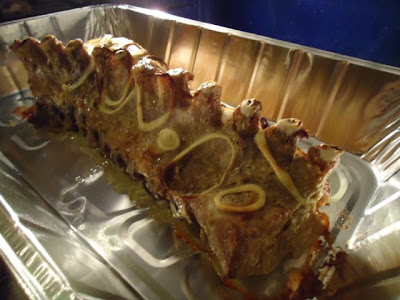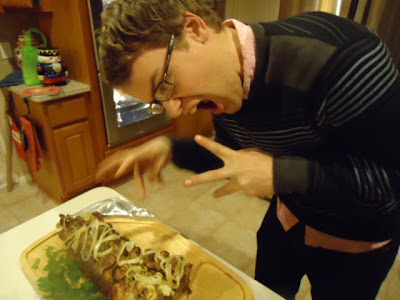 Cuban Sandwiches made of sliced pork, ham, swiss cheese, mustard, and a dill pickle. Traditionally there is no mayonnaise on the sandwich, and the outside of the bread is slathered in butter before the sandwich is pressed in either a panini pan or a sandwich press. On December 24th we usually send out my father, the authority on Cuban Sandwiches, to search for the perfect bread for Cuban sandwiches. The bread used is neither a baguette nor a bocadillo loaf (small sandwich loaf). The perfect bread is the length of a hoagie roll but not as soft. The key is for the bread to be soft enough to press and retain grill marks, but a Cuban sandwich is not supposed to be as thin as an Italian panini. The bread used in Cuban sandwiches is ubiquitous in stores like Fiesta that cater to Hispanic tastes, but our local grocery store does really have an equivalent, so this year we used small baguettes that tasted fine but didn't get the grill marks of the perfect sandwich.
Cuban Sandwiches made of sliced pork, ham, swiss cheese, mustard, and a dill pickle. Traditionally there is no mayonnaise on the sandwich, and the outside of the bread is slathered in butter before the sandwich is pressed in either a panini pan or a sandwich press. On December 24th we usually send out my father, the authority on Cuban Sandwiches, to search for the perfect bread for Cuban sandwiches. The bread used is neither a baguette nor a bocadillo loaf (small sandwich loaf). The perfect bread is the length of a hoagie roll but not as soft. The key is for the bread to be soft enough to press and retain grill marks, but a Cuban sandwich is not supposed to be as thin as an Italian panini. The bread used in Cuban sandwiches is ubiquitous in stores like Fiesta that cater to Hispanic tastes, but our local grocery store does really have an equivalent, so this year we used small baguettes that tasted fine but didn't get the grill marks of the perfect sandwich.Wednesday, December 29, 2010
Christmas Day Cuban Sandwiches
In my family, Cuban Sandwiches are a Christmas day tradition. Since we prepare an enormous amount of pork the day before for Noche Buena, the best way to make a dent into so much pork is to carve it up and serve it in sandwiches. Cuban Sandwiches made of sliced pork, ham, swiss cheese, mustard, and a dill pickle. Traditionally there is no mayonnaise on the sandwich, and the outside of the bread is slathered in butter before the sandwich is pressed in either a panini pan or a sandwich press. On December 24th we usually send out my father, the authority on Cuban Sandwiches, to search for the perfect bread for Cuban sandwiches. The bread used is neither a baguette nor a bocadillo loaf (small sandwich loaf). The perfect bread is the length of a hoagie roll but not as soft. The key is for the bread to be soft enough to press and retain grill marks, but a Cuban sandwich is not supposed to be as thin as an Italian panini. The bread used in Cuban sandwiches is ubiquitous in stores like Fiesta that cater to Hispanic tastes, but our local grocery store does really have an equivalent, so this year we used small baguettes that tasted fine but didn't get the grill marks of the perfect sandwich.
Cuban Sandwiches made of sliced pork, ham, swiss cheese, mustard, and a dill pickle. Traditionally there is no mayonnaise on the sandwich, and the outside of the bread is slathered in butter before the sandwich is pressed in either a panini pan or a sandwich press. On December 24th we usually send out my father, the authority on Cuban Sandwiches, to search for the perfect bread for Cuban sandwiches. The bread used is neither a baguette nor a bocadillo loaf (small sandwich loaf). The perfect bread is the length of a hoagie roll but not as soft. The key is for the bread to be soft enough to press and retain grill marks, but a Cuban sandwich is not supposed to be as thin as an Italian panini. The bread used in Cuban sandwiches is ubiquitous in stores like Fiesta that cater to Hispanic tastes, but our local grocery store does really have an equivalent, so this year we used small baguettes that tasted fine but didn't get the grill marks of the perfect sandwich.
 Cuban Sandwiches made of sliced pork, ham, swiss cheese, mustard, and a dill pickle. Traditionally there is no mayonnaise on the sandwich, and the outside of the bread is slathered in butter before the sandwich is pressed in either a panini pan or a sandwich press. On December 24th we usually send out my father, the authority on Cuban Sandwiches, to search for the perfect bread for Cuban sandwiches. The bread used is neither a baguette nor a bocadillo loaf (small sandwich loaf). The perfect bread is the length of a hoagie roll but not as soft. The key is for the bread to be soft enough to press and retain grill marks, but a Cuban sandwich is not supposed to be as thin as an Italian panini. The bread used in Cuban sandwiches is ubiquitous in stores like Fiesta that cater to Hispanic tastes, but our local grocery store does really have an equivalent, so this year we used small baguettes that tasted fine but didn't get the grill marks of the perfect sandwich.
Cuban Sandwiches made of sliced pork, ham, swiss cheese, mustard, and a dill pickle. Traditionally there is no mayonnaise on the sandwich, and the outside of the bread is slathered in butter before the sandwich is pressed in either a panini pan or a sandwich press. On December 24th we usually send out my father, the authority on Cuban Sandwiches, to search for the perfect bread for Cuban sandwiches. The bread used is neither a baguette nor a bocadillo loaf (small sandwich loaf). The perfect bread is the length of a hoagie roll but not as soft. The key is for the bread to be soft enough to press and retain grill marks, but a Cuban sandwich is not supposed to be as thin as an Italian panini. The bread used in Cuban sandwiches is ubiquitous in stores like Fiesta that cater to Hispanic tastes, but our local grocery store does really have an equivalent, so this year we used small baguettes that tasted fine but didn't get the grill marks of the perfect sandwich.Noche Buena Dinner
 The Cuban tradition is to eat Christmas dinner on Christmas Eve and then roll to Midnight Mass after a meal of pork, yucca, black beans and rice, followed by flan and turròn, all washed down with excellent wine, port, and coffee. Now that I'm older and struggle incredibly during midnight mass to stay awake after such as a massive meal, I really respect the effort my parents exerted when we were younger present a perfect Christmas eve. They used to host a Noche Buena party for friends, go to Midnight mass, come home to clean up the mess and then stay up until 3am assembling toys and arranging them under the tree for their sleeping children who were counting on Santa Claus to deliver the goods.
The Cuban tradition is to eat Christmas dinner on Christmas Eve and then roll to Midnight Mass after a meal of pork, yucca, black beans and rice, followed by flan and turròn, all washed down with excellent wine, port, and coffee. Now that I'm older and struggle incredibly during midnight mass to stay awake after such as a massive meal, I really respect the effort my parents exerted when we were younger present a perfect Christmas eve. They used to host a Noche Buena party for friends, go to Midnight mass, come home to clean up the mess and then stay up until 3am assembling toys and arranging them under the tree for their sleeping children who were counting on Santa Claus to deliver the goods.The protein for the traditional Noche Buena is pork, usually leg, pierna, marinated either in a garlic paste that contains salt, pepper, oregano, and olive oil or the traditional Goya product, mojo criollo, which is a combination of garlic, onion and citrus. This year my mother served a pork rib roast that we marinated in the garlic paste for 2 hours, and eventually poured mojo criollo while it cooked.

The pork is accompanied by boiled yucca that is covered in mojo de ajo, which is sweated onions that are first marinated for an hour in sour orange juice mixed with mashed garlic. Also served at dinner is black beans and rice or Congrì (black beans and rice cooked together), plantains, and water cress salad. Sadly, I only captured the yucca on camera, but yucca is my favorite component of the meal. The finished pork roast.
The finished pork roast.
 The finished pork roast.
The finished pork roast. My good friend Johnous, about to pounce on the pork roast.
My good friend Johnous, about to pounce on the pork roast.
End of the Year Eating
 It's been a great year of eating and cooking here at Kitchen Pulse, and I'm happy to share my end of the year meals with my faithful readers. Though I've been lagging in my posting in November and December, one of my many New Year's resolutions is to post regularly on my blog and return to my original intention of blogging cook books and maybe a few original recipes.
It's been a great year of eating and cooking here at Kitchen Pulse, and I'm happy to share my end of the year meals with my faithful readers. Though I've been lagging in my posting in November and December, one of my many New Year's resolutions is to post regularly on my blog and return to my original intention of blogging cook books and maybe a few original recipes.I spent my Christmas holiday in Georgetown, Texas cooking for my family with my mother. She was the architect of the great paella de mariscos I posted in September. Though my mother is the chef and primary grocery shopper of the household, sometimes my father brings home food that is given as a gift by his patients. The week I was home for Christmas, my mother prepared venison and Texas red fish, both items were gifts from my father's patients.
The venison was a cut of meat called back strap which is two long strips of meat taken from along the spine of the deer. The meat we cooked was already cut into small pieces, so it looked like each piece was cut from an individual vertebrae.

The venison was prepared as fajita meat, marinated in wine and vinegar to tenderize the meat and then served with sauteed onions and colored bell peppers, guacamole, tortillas, and homemade charro beans.

The next night we ate delicious Texas red fish caught in the Gulf of Mexico by a fisher woman. Texas Red Fish, as one sustainable fishing site put it, is too delicious for its own good, so Red fish is a commercially protected species and most Red Fish you eat in restaurants is farmed. I recently ate farmed red fish when I visited Galveston, Texas for an interview, and compared to the fish I ate there, the fresh fish my family ate was indescribably better. The fresh caught fish had the subtle taste of the ocean without a fishy taste. This is the type of fish that you eat and each bite of light flaky goodness leaves you wanting more. My mother encrusted the fish in pecans and panko and pan fried the fillets until they were slightly browned. The fish was cooked to perfection and all it needed was a bit of lemon as seasoning.


Subscribe to:
Posts (Atom)

